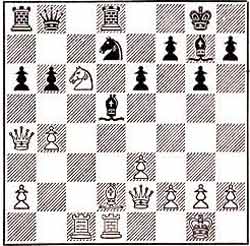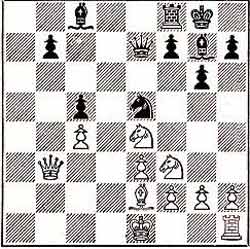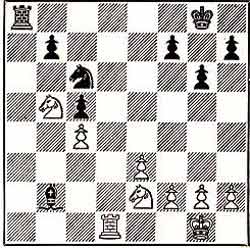|
R A D I O M A T C H R E V I E W E D
|
||
10. Anthony Santasiere vs. David Bronstein notes by I. A. Horowitz CHESS REVIEW MAY 1946 |
22 P-N3 B-B2 Now this deflection from the important diagonal leaves White all opening for greater stakes than a mere Pawn.
23 Q-KN5 B-K4 A positional stroke which demolishes Black's Pawn structure and leaves him easy prey in the endgame.
25 . . . . RxRch Naturally not 26…..BxB; 27 R-Q8ch etc.
27 BxB QxB Net result: White is a Pawn to the good, but Black's passed Pawn must be stopped dead in its tracks.
31 . . . . P-QR4 For on 32, .. P-R5; 33 R-K4 picks off the Pawn. E.g., 33 ... P-R6; 34 RxN, P-R7; 35 B-N3ch, etc.
33 B-R4 N-Q6 At first sight, the text move seems to offer the best chance. While a complete analysis would be too voluminous, better prospects are in sight after 35 ... NxB. quickly followed by a King excursion to the Queen-side to support the passed Pawn. This procedure frees the Black Rook to penetrate on one of the open files and to harry the opposition with tactical threats. 36 K-B1 . . . . Now White's King gets a head to nip any such plan in the bud.
36 . . . . R-B8ch Pure momentum. Only a feeble resistance is possible.
41 B-B2 P-R4 For on 45….P-R6; 46 K-B3, Black’s Knight is trapped.
46 K-B3 N-Q3 From here on Black remains with skin and bones and little of that.
47 . . . . RxR
|
|
|
The double fianchetto. Black's structure is sound but delicate. The exchange of either of his Bishops perforates the structure. 9 R-Ql QN-Q2 A la Reti in truly hypermodern
fashion, but lacking the touch and technique. 12 BPxP . . . .
12 . . . . NxP 12 ... KPxP; 13 PxP, PxP results in hanging center Pawns. But their weakness is compensated for in their control of important squares. However, judgment and technique of the highest order are essential to this strategy. 13 Q-R4! . . . . Lending itself to such tactical threats as B-R6 and the weakening of the white squares in Black's Queen•side Pawn structure. Black's lagging development and flank congestion leave him without too happy a solution. |
The alternative 14 …PxKt still gives the position resiliency and flexibility at the expense of hanging Pawns. Yet, there is no approach to exploit them. 15 P-QN4! . . . . Forcing open the file. 15 . . . . PxQP 15 ... PxNP offer's better prospects. For one thing, White's Knight does not assume the commanding position it enjoys in the game. Again, Black's long term prospects are enhanced by his Queen•side Pawn majority. 16 NxP P-QR3 Not 16 ... BxN as Black cannot afford to part with his valuable Bishop. 17 N-B6 . . . . Duress! One of the Bishops must go and Black's Queen-side is breached.
17 . . . . BxN
Ill timed and a decisive blunder. For now White has a direct target in the
Queen•side Pawns, as the ensuing play discloses. Better is 18…. N-K4 with
a view to liquidating, achieving Bishops of opposite colors and aiming for
the draw. 19 P-QR4! PxP Black's Queen's Rook Pawn becomes the target.
20 QxP(4) N-N3 Temporary tactical measures defer the immediate loss of the Pawn.
|
|
|
||
|
1 N-KB3
N-KB3 When P-QN4 is played on the first
move, the opening is regarded as the Orangoutang, to commemorate Dr.
Tartakover's visit to the Bronx Zoo during tile New York 1924 Masters
Tournament. When it is played on the second move, it is a hybrid
Orangoutang, or an Orangoutang Deferred or possibly, as Santasiere prefers
to call it, Santasiere's f'olly. But whatever Its "monniker", an
Orangoutang by any other name smells just as sweet. 2 . . . . P-Q3 One of a variety of defenses. Since White's Bishop is headed for QN2, Black bolsters the black squares to counteract its influence. 3 P-Q4
P-Kn3 Clashing with the advanced Pawn. 7 P-QR3 . . . . For if 7 P-N5, White is duty bound to maintain his Queen's Pawn on its present square as otherwise Black will occupy his QB4 with a Knight to advantage. 7 . . . . P-K4 Technically feasible. 8 PxKP . . . . The alternative 8 P-K3 is met by …P-K5, compelling the abject retreat 9 N-KN1. For 9 N-N-5 leaves the Knight on a limb. 8 P-K4 would not do as after the exchange …. PxP, White’s King Pawn would set up as a target. 8 P-Q5 would commit White to a Queen-side attack as against which, Black would counter wIth a King•side assault. Of the two, the latter Is the more dangerous. 8 . . . .
KN-Q2! But here, the logical continuation appears to be the fianchetto of the KB with 9 P-KN3. For at KN2, the Biship bears down on the commanding diagonal, where in conjunction with the advanced Queen-side Pawns, some pressure might be worked up against Black's right flank. Black's last is double-edged. While it fixes White's QBP as an immobile target, It leaves Black's QP backward.
|
That Bishops are more valuable than
Knights is conceded among masters. There Is no special reason, under the
circumstances for parting with the Bishop. Correct is 16 O-O, followed by
R-Q1 with pressure on the QP. Dissipating the weakness of Black's Queen's Pawn but in turn clearing the approach to Black's remaining Pawns on the Queen's wing. In addition, White hopes to profit from the fact that his Queen's Bishop Pawn holds two of Black,'s Pawns in check. 17 . . . . PxP
18 O-O . . . . 18 Q-N5 might be met by ….P-N3. For if then 19 QxNP, NxP is good enough. 18 N-B3 is not good: 18 ... NxNch: 19 BxN, Q-K4; 20 N-Q5, Q-R8ch; 21 B-Ql, Q-R4ch; and wherever the King goes, he Is not only in danger but also interferes with the natural development of his forces. 18 . . . .
B-N5 Incomprehensible. Surely, the thought of a doubled Pawn is not enough to alarm the most timid. 19 R-QNl, with pressure on the adverse QNP is indicated. 19. . . . N-B3! To occupy QN5 and lessen the pressure on the NP. 20 R-Q1 N-N5 Aiming for Q5 via B3. It is difficult to suggest a good plan. 21 . . . . Q-B3 The Knight is now sidetracked instead of centralized.
22 . . . . R-R1 To simplify, but Black is not unwilling. His attention will focus on White's weak Queen Bishop Pawn.
23 . . . .
BxB
Compelling the exchange of Queens. |
Threatening 27 ... R-R5.
Time wasting, as the Bishop is immune to capture. But in any event White's task is cut out for him. For instance: 27 P-B4, N-R4; 28 N-Q6, R-Ql, when the pin is annoying. Or 27 P-B4, N-R4; 28 R-Q7, NxP; 29 RxNP, NxKP; 30 N-Q6, N-N5 (threatening mate). Black's passed Pawn plus the insecurity of White's King rule In Black's favor.
27 . . . . R-R5 Defending his own weak Pawn and maintaining the attack on the enemy Pawn. 31 R-QB1 P-B4 Black's technique is good. He will drive White's Knight from Q6, doubly attack and pick off the Queen's Bishop Pawn. 32 P-K4 . . . . Necessary to obtain counterplay. 32 . . . . B-Q5ch But now the Bishop comes into its own.
33 K-R1 B-K6!
The game may be over with precision
41 N-K4? P-B5
2 K-N1, B-N7 and the King Is too late.
|
<Sommario>



